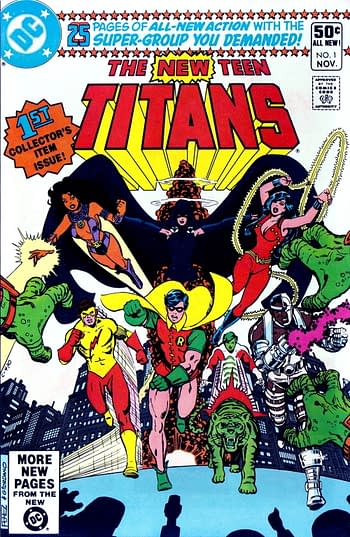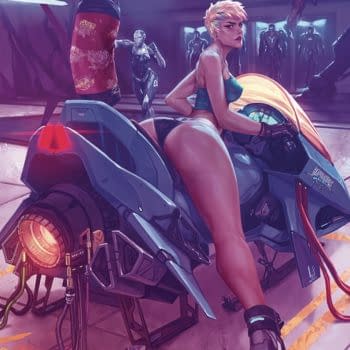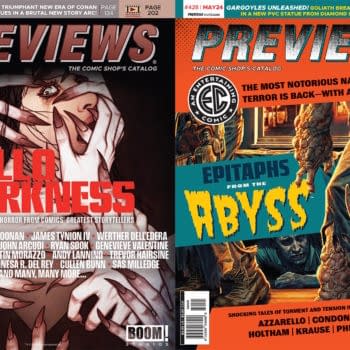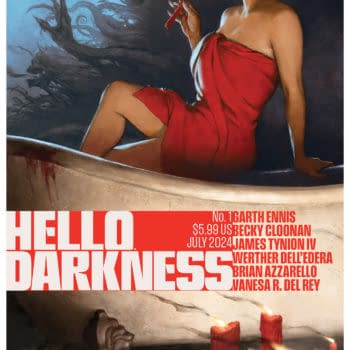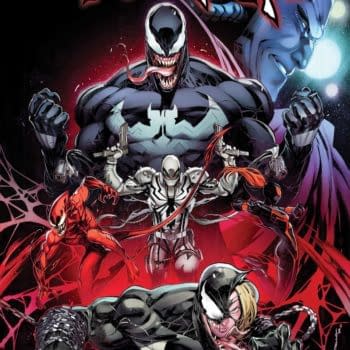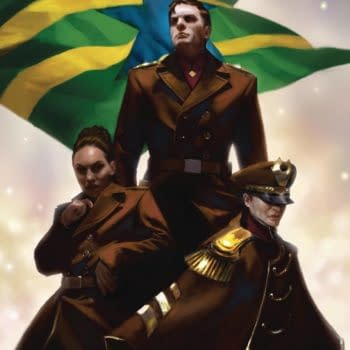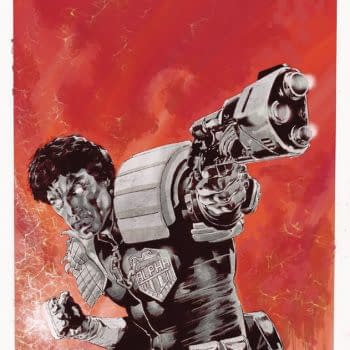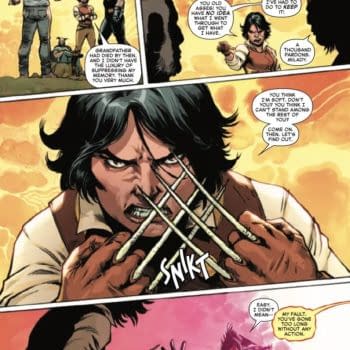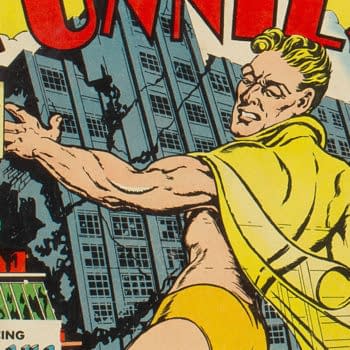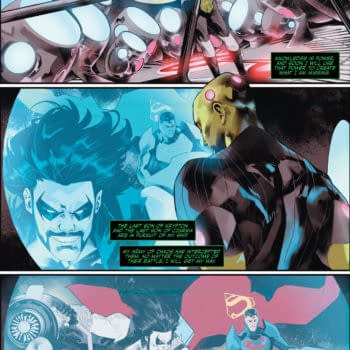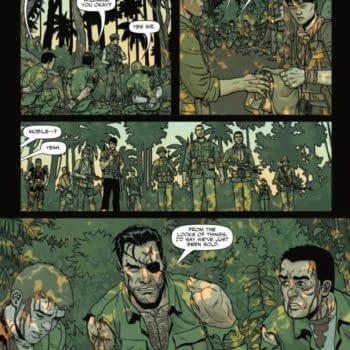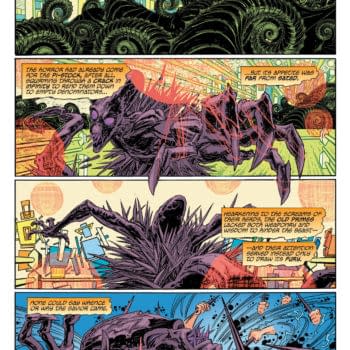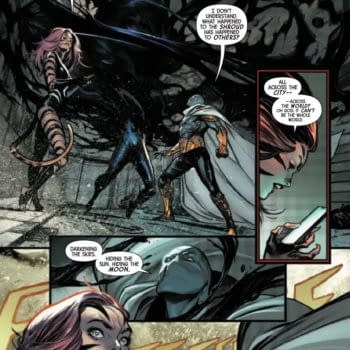Posted in: Comics | Tagged: alan davis, frank cho, Goerge Perez, klaus janson, lake como, lccaf, neal adams
Neal Adams/George Pérez Tribute Panel At Lake Como Comic Art Festival
Alan Davis, Frank Cho and Klaus Janson led the Neal Adams/George Pérez Tribute Panel at Lake Como Comic Art Festival this weekend. Neal had been an attendee at the show and has given some advice to one of the show organisers at the Villa Erba opening gala in the grounds of the house. "If you want to be happy, just look up.". Those who have seen the photos of the place know just what he meant.
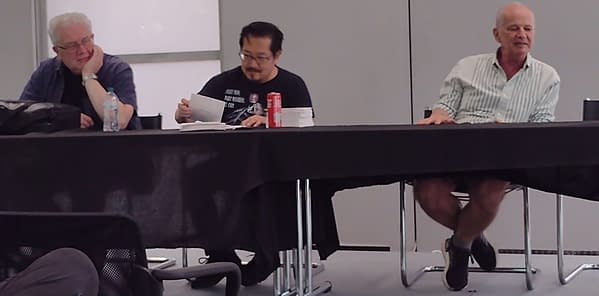
All three panellists knew Neal Adams well. Klaus Janson met Neal when he was 18 or 19, the same day as he met Dick Giordano, his mentor. Klaus had tricked his way into the DC offices to try and get work, and Neal Adams in a corner, drawing an Adam Strange cover, and he explained to Klaus what he was doing. He was working on a colour scheme to create depth, a 3D effect, with the foreground red and white of Adam Strange popping out of the olive green behind him. Klaus said that Adams' ability to create depth was a standout ability in comics and one of the most difficult things young artists have to understand and do.

Soon Klaus would start working at Neal Adams' Continuity Studios, which he describes as the end of the Mad Men period. Everyone wore suits and ties, and indeed Neal Adams kept that up through his life, and he lived in a section of Connecticut where all the newspaper strips artists, and advertising artists lived. Janson emphasised how tough Neal Adams was to other upcoming artists and would regularly tell people to give up.
Frank Cho recalled, "he made Frank Miller destroy Frank Miller" telling us that Neal was brutally honest, ripped the young Frank's work apart – ad Frank as well, but educated Frank where he went wrong. And he would do this several times, and Frank Miller would go to the lobby and cry. What impressed Neal was Frank kept coming back and eventually when he got good enough, Adams got him a job at Gold Key, and then Marvel.
Klaus Janson confirmed that Frank Miller would ask Neal Adams what he was doing wrong, and tell him how to get better. That he was tough but generous with his time.
Frank Cho added that Adams was generous with his knowledge as well. "He could be really hard on you. I was never on the receiving end. But I would see him with artist portfolios, and he was brutal."
Klaus Janson believes that no one from this generation could survive a critique from Neal. Not that Adams appreciated those who would come back and ask for more." I even got the chance to add something Neal Adams once said, when Frank Miller showed him some pages from his Marvel test, and Neal ripped them apart as usual. only for Frank to say that Marvel had bought the pages and were going to publish them, should he ask for them back so he could fix them? Only for Neal to suddenly reverse course, tell him "NO!" and that if he had managed to get an editor to buy them, then there was nothing more that needed doing, and you never want to put doubt in that editor's mind.
Alan Davis told us "I never saw Neal's tough side, just incredible kindness." Explaining an unusual meeting at San Diego Comic-Con with mixed up badges, after they met, they would spend time together at every show they were both at, and that Neal would always have a story, usually asking how much you should charge for your signature and sketches. Neal Adams was famous for believing that comic creators should value their work and reputation more, including increasing prices on sketches and charging for signatures. And that he once went to front of Davis' queue, asking the fan how much he was paying for that sketch, didn't they think it is too cheap, and isn't it an insult to pay that little?
Klaus Janson added that Neal grew up in a time when business was tough, where if you cant take knocks, you won't survive. He wanted people to learn how to do their job and learn it better than the person telling them what to do.
Frank Cho also wanted to talk about Neal Adams' childhood. At an otherwise "dead" show, when they went to eat together, Frank got the chance to ask Neal about his background. Neal's dad left his family when he was young so Neal became the "man of the house" aged ten. His mother had opened up a boarding house, and Neal told Frank stories of the people who went through the house. And that when he was a teenager, someone almost blew him up. His aunt had been dating an ex-soldier from the Korean war, then dumped him. Enraged, the soldier went crazy, leading the aunt to take refuge with her sister. And it was while the three of them were having coffee in the kitchen, that an explosion shook the house. And for the aunt to tell them "he has grenades." "How many grenades?" Neal asked before going to confront the guy with a butcher's knife, and found a big crater in the yard. Only to see the former soldier walking into their house with a wrench, as a police car turned up the street. He quickly ditched the knife so as not to get shot. Hailing the police, he told them the situation. "How many grenades?" they asked. They arrested the wrench-wielding soldier, went through his truck and found a very big box of grenades, with no idea how he could have got them. But as Frank says, that wasn't the craziest story.
It might have been a little earlier, the first time Neal Adams saw a naked woman. Again, he and his mother were in the kitchen drinking coffee, when they heard a scream from one of the guests. and found him naked holding his head in his hands, covered in blood, while his naked younger wife, also covered in blood went up to Neal with growing face and hands, hissing at him. Neal's mother told her, "do you mind? This is my son". She got dressed and left the house, while they tried to clean up her husband – and the room. Later, back in the kitchen having coffee (everything seemed to interrupt them when they were doing this), she started getting phone calls from three different houses down the street that the woman had been defecating in their garden. It was clearly that kind of neighbourhood.
Klaus Janson believes that because Neal's father left, Neal became very protective of his mother, and that's what he was like as an adult. He took care of people, and kids, becoming the daddy of an entire generation. And that everyone knows what he did representing Superman's creators Siegel and Shuster, against DC Comics, to get some kind of recompense for the character when the movie hit, establishing artists' rights including royalties and share, as well as getting original artwork back for creators, something that has helped so many in their older age.
Frank Cho mentioned that Neal Adams would make calls to editors and publishers and get you a job if he thought you were ready. And that publishers took his recommendations on that alone.
Alan Davis has a strong personal memory of telling Neal how much he meant to him, highlighting his work on X-Men #56, compared to other comics, everything else wasn't real, and Neal Adams became the standard he had to measure himself against. Neal Adams revolutionised his thinking, and he was so pleased he was able to tell him. Klaus Janson believes his run on X-Men should have been placed higher in the critical consensus and deserves to be up there with Watchmen and Dark Knight, he considered it to be absolutely seminal, and it holds up today, alongside anything anyone is doing now. Davis and Cho concurred. Davis was critical of those who criticised Neal Adams, especially his older work, as Adams was always trying new things and sometimes he would fail. That he was always challenging himself, a groundbreaking artist, forcing his way through so that everyone could follow. A real trailblazer.
Klaus Janson cited his approach to the panel layout, getting away from the grid, which would influence so many others. Alan Davis highlighted his double-page spread of the city in Superman Vs Mohammad Ali. Frank Cho looked at his massive shift in comic book style to realism that was a primary influence on the likes of John Byrne, Frank Miller, Bill Sienkiewicz, Dave Sim, Garcia Lopez, Jim Aparo, and so many more. Alan Davis stated that when he started on Batman, he had never seen Neal Adams work on the character, just the Jim Aparo and Don Newton Batman, which Neal had inspired. And that artists could take one aspect of Neal's work, copy it and then base an entire career on it.
They also talked more briefly about George Pérez, as none of them had the close experiences with Pérez as they had with Adams. Klaus Janson recalled his first work with Peres on a biography of the Beatles and a couple of issues on Logan's Run, and that he is lucky to have such good memories of that specific period of time, what he sees as a Marvel golden age with George Pérez. And that George was genuinely happy doing exactly what he was doing, a rare experience. Frank Cho recalled that he was a Marvel Comics reader and only read New Teen Titans from DC, it was a tribute to the power of Pérez' work that he could drag him from Marvel.
Klaus Janson summed this up, saying that the goal of storytelling is to communicate and solve problems, to answer how you do something and how you do it effectively. George and Neal solved problems differently but they solved the problems, and it's something to be admired.
The Lake Comic Comic Art Festival is a comic book convention that takes place in Villa Erba, Cernobbio, Como in Italy every year (pandemic allowing). It focuses on big-name comic book artists from the USA, the UK, and mainland Europe, and attracts fans, collectors and dealers with a cap on attendance and a relatively high price. This affords greater access to creators, and for creators to maximise their earnings, all in the incredibly attractive scenery, culture, history, art and architecture of Lake Como.


